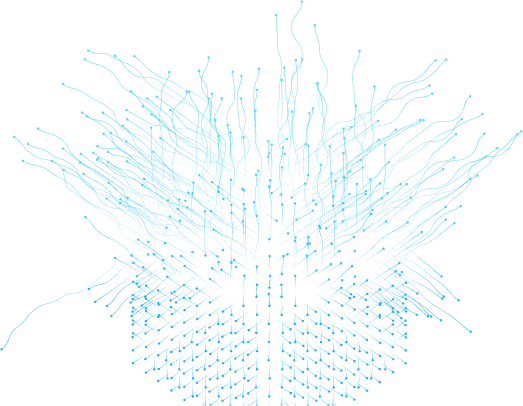
What is Avalanche Subnets & How Does it Work?
Table of Contents
Avalanche Subnets are a network inside the network. These subnetworks are validator nodes that provide scalability and improved performance by reaching consensus on transactions on other blockchains in these subnets instead of on the main network.
Scalability has always been one of blockchain’s major pain points. Avalanche’s approach is diverting the traffic from the main net onto these subnets.
In this article, we’ll look deeper into avalanche subnets, their benefits, applications, and how they can change what blockchain can do.
To start, let's focus on the Avalanche subnets explained.
Avalanche Blockchain
The avalanche blockchain is not one but three blockchains that work together to achieve the functionality. The three components of the Avalanche network are:
-
Exchange chain
-
Platform chain
-
Contract chain
The exchange chain, or X-chain, creates and exchanges network assets, including sending, swapping, and receiving funds. This chain runs the avalanche protocol consensus.
The contract chain is the most active chain of the avalanche network. This chain is forked from the Ethereum Geth client to add support for the Ethereum Virtual Machine (EVM). The C-chain is responsible for executing smart contracts. ERC20 token dealing, NFTs creation and dealing, and as everything to do with DApps occur on this chain in the avalanche network. This chain runs the Snowman Consensus Protocol.
The platform chain, or P-Chain, creates subnets on the avalanche network and coordinates with the validators. It allows users to stake their 2000 AVAX for becoming a validator, i.e., creating a subnet. It, too, runs the Snowman Consensus Protocol.
What are subnets?
According to Avalanche’s website,
As mentioned, scalability has been a pain point in blockchain technology. As the volume of transactions has increased, the transaction times have increased continuously, and the gas fees have increased, going higher and higher, meaning one has to pay a significant amount now for their transaction to be validated on priority.
One of the ways the blockchain world has dealt with this is by introducing a layer-2 solution. The L2, or layer 2, is a secondary blockchain atop the main blockchain, or L1. L2 provides ORU or optimistic rollups, which perform the transactions on Layer 2 before sending them for consensus to Layer 1. While rollups provide quicker transaction times and lower gas fees, they have a downside: If a transaction is challenged, it can stay frozen for up to a week. Smart contract bugs and vulnerabilities become more highlighted as well.
Avalanche Blockchain came up with another solution for their network, which targets the scalability problem with a more potentially viable approach: Avalanche subnets.
What is an Avalanche subnet?
Avalanche subnets are validators of the avalanche network. These validators run a blockchain on themselves and reach a consensus on it.
Since these validators run their blockchain, a separate financial mechanism is likely present, i.e. token, fee, and economy. Validators on an avalanche can often be paid the incentive in their token.
When a subnet is created by staking AVAX, it can create its own rules, including the underlying mechanisms of the chain running on it.
The validator can customize the following in the subnet:
-
Token/fee structure of the blockchain
-
Choose whether the blockchain is permissioned or permissionless
-
Validator performance requirements
-
Privacy
-
Validatory incentives
How do Avalanche subnets work?
Avalanche’s architecture consists of subnets, each subnet has its own validators. Each validator is distinct from those on other subnets. Validators can stake AVAX tokens, having the option to join or leave a subnet. However, the minimum staking requirement is set by subnet governance rules.
This subnet design embraces decentralization, customization, and security while allowing validator mobility and dynamic governance adoption. Moreover, subnet isolation enhances fault tolerance and scalability, making Avalanche a versatile and efficient blockchain ecosystem. Following the prime components of Avalanche Subnets:
-
Decentralized Validation
-
Customized Validator Sets
-
Validator Mobility
-
Staking and Incentives
-
Governance Dynamics
-
Security and Fault Tolerance
-
Scalability and Efficiency
Advantages of Avalanche Subnets
Decreasing traffic to the main net aside, the avalanche subnets provide other benefits as well:
-
Easy scalability: The subnets are easily scalable because no two subnets compete with each other, as many can be added
-
Decreased gas fee: As blockchains without subnets had to increase gas fees due to bottleneck, subnets reduce the gas fee needed for a transaction
-
Increased validated transactions per second: As the bottleneck is cut down, the throughput the subnets offer is larger than another blockchain of the same number of transactions incoming
-
Interoperability: Interoperability, or the ability of a blockchain to interact with other blockchains, is supported with the help of subnets
-
Validator selectivity: Validators can opt out of whether or not they want to participate in the validation of transactions on a certain blockchain.
-
Extensive customization options: As mentioned above, the validators have the option to customize their subnet
Uses of Avalanche Subnets
Subnets can support a wide range of applications. According to Avalanche and Coinbase, two subnets are up and running.
The DeFi Kingdom, a play-to-earn game was the first to launch. It was initially on the Harmony blockchain. As the game became popular, the developers wanted more control over the underlying mechanisms and additionally, to self-manage the finances. Avalanche’s subnets offered them all of their requirements. The DeFi Kingdom subnets about 200k transactions per day.
The other subnet is also a play-to-earn game. Crabada was initially on the Avalanche network itself. By launching Crabada on a subnet, they decreased the game’s cost and switched to their token.
Difference b/w Avalanche Subnet and Polygon Supernet
Another chain that offers a subnet-like technology is the polygon. Let’s quickly take a look at how they are different.
Closing thoughts
As the world of DeFi progresses and as blockchain technology becomes more and more common, a scalability solution that offers control to the creator will become an even bigger need.
With traditional setups limiting the transaction throughput and increasing the amount of gas fees, Avalanche’s subnets offer a scalable and viable solution.
According to Avalanche’s website,
“Subnets are the most powerful solution yet devised for the problem that has been called the "blockchain trilemma": the traditional inability to develop a blockchain that can adequately address and balance the needs for security, scalability, and decentralization without sacrificing any one of those components.”
That being said, the subnetting benefits aren’t going to remain exclusive to Avalanche alone, and we can expect a bloom in their use in the future.
Table of Contents
Avalanche Subnets are a network inside the network. These subnetworks are validator nodes that provide scalability and improved performance by reaching consensus on transactions on other blockchains in these subnets instead of on the main network.
Scalability has always been one of blockchain’s major pain points. Avalanche’s approach is diverting the traffic from the main net onto these subnets.
In this article, we’ll look deeper into avalanche subnets, their benefits, applications, and how they can change what blockchain can do.
To start, let's focus on the Avalanche subnets explained.
Avalanche Blockchain
The avalanche blockchain is not one but three blockchains that work together to achieve the functionality. The three components of the Avalanche network are:
-
Exchange chain
-
Platform chain
-
Contract chain
The exchange chain, or X-chain, creates and exchanges network assets, including sending, swapping, and receiving funds. This chain runs the avalanche protocol consensus.
The contract chain is the most active chain of the avalanche network. This chain is forked from the Ethereum Geth client to add support for the Ethereum Virtual Machine (EVM). The C-chain is responsible for executing smart contracts. ERC20 token dealing, NFTs creation and dealing, and as everything to do with DApps occur on this chain in the avalanche network. This chain runs the Snowman Consensus Protocol.
The platform chain, or P-Chain, creates subnets on the avalanche network and coordinates with the validators. It allows users to stake their 2000 AVAX for becoming a validator, i.e., creating a subnet. It, too, runs the Snowman Consensus Protocol.
What are subnets?
According to Avalanche’s website,
As mentioned, scalability has been a pain point in blockchain technology. As the volume of transactions has increased, the transaction times have increased continuously, and the gas fees have increased, going higher and higher, meaning one has to pay a significant amount now for their transaction to be validated on priority.
One of the ways the blockchain world has dealt with this is by introducing a layer-2 solution. The L2, or layer 2, is a secondary blockchain atop the main blockchain, or L1. L2 provides ORU or optimistic rollups, which perform the transactions on Layer 2 before sending them for consensus to Layer 1. While rollups provide quicker transaction times and lower gas fees, they have a downside: If a transaction is challenged, it can stay frozen for up to a week. Smart contract bugs and vulnerabilities become more highlighted as well.
Avalanche Blockchain came up with another solution for their network, which targets the scalability problem with a more potentially viable approach: Avalanche subnets.
What is an Avalanche subnet?
Avalanche subnets are validators of the avalanche network. These validators run a blockchain on themselves and reach a consensus on it.
Since these validators run their blockchain, a separate financial mechanism is likely present, i.e. token, fee, and economy. Validators on an avalanche can often be paid the incentive in their token.
When a subnet is created by staking AVAX, it can create its own rules, including the underlying mechanisms of the chain running on it.
The validator can customize the following in the subnet:
-
Token/fee structure of the blockchain
-
Choose whether the blockchain is permissioned or permissionless
-
Validator performance requirements
-
Privacy
-
Validatory incentives
How do Avalanche subnets work?
Avalanche’s architecture consists of subnets, each subnet has its own validators. Each validator is distinct from those on other subnets. Validators can stake AVAX tokens, having the option to join or leave a subnet. However, the minimum staking requirement is set by subnet governance rules.
This subnet design embraces decentralization, customization, and security while allowing validator mobility and dynamic governance adoption. Moreover, subnet isolation enhances fault tolerance and scalability, making Avalanche a versatile and efficient blockchain ecosystem. Following the prime components of Avalanche Subnets:
-
Decentralized Validation
-
Customized Validator Sets
-
Validator Mobility
-
Staking and Incentives
-
Governance Dynamics
-
Security and Fault Tolerance
-
Scalability and Efficiency
Advantages of Avalanche Subnets
Decreasing traffic to the main net aside, the avalanche subnets provide other benefits as well:
-
Easy scalability: The subnets are easily scalable because no two subnets compete with each other, as many can be added
-
Decreased gas fee: As blockchains without subnets had to increase gas fees due to bottleneck, subnets reduce the gas fee needed for a transaction
-
Increased validated transactions per second: As the bottleneck is cut down, the throughput the subnets offer is larger than another blockchain of the same number of transactions incoming
-
Interoperability: Interoperability, or the ability of a blockchain to interact with other blockchains, is supported with the help of subnets
-
Validator selectivity: Validators can opt out of whether or not they want to participate in the validation of transactions on a certain blockchain.
-
Extensive customization options: As mentioned above, the validators have the option to customize their subnet
Uses of Avalanche Subnets
Subnets can support a wide range of applications. According to Avalanche and Coinbase, two subnets are up and running.
The DeFi Kingdom, a play-to-earn game was the first to launch. It was initially on the Harmony blockchain. As the game became popular, the developers wanted more control over the underlying mechanisms and additionally, to self-manage the finances. Avalanche’s subnets offered them all of their requirements. The DeFi Kingdom subnets about 200k transactions per day.
The other subnet is also a play-to-earn game. Crabada was initially on the Avalanche network itself. By launching Crabada on a subnet, they decreased the game’s cost and switched to their token.
Difference b/w Avalanche Subnet and Polygon Supernet
Another chain that offers a subnet-like technology is the polygon. Let’s quickly take a look at how they are different.
Closing thoughts
As the world of DeFi progresses and as blockchain technology becomes more and more common, a scalability solution that offers control to the creator will become an even bigger need.
With traditional setups limiting the transaction throughput and increasing the amount of gas fees, Avalanche’s subnets offer a scalable and viable solution.
According to Avalanche’s website,
“Subnets are the most powerful solution yet devised for the problem that has been called the "blockchain trilemma": the traditional inability to develop a blockchain that can adequately address and balance the needs for security, scalability, and decentralization without sacrificing any one of those components.”
That being said, the subnetting benefits aren’t going to remain exclusive to Avalanche alone, and we can expect a bloom in their use in the future.
FAQS
To setup you subnet configuration you need to go through following steps:
- First, choose your Virtual Machine select SubnetEVM
- Enter Subnet’s ChainID and select a positive integer for your EVM ChainID
- Token Symbol Enter a string to name your token
- Configure Gas Fee
- Set Airdrop tokens to default address
- Use precompiles to customize Subnet behavior
- Deploy your first subnet
When you build a subnet on Avalanche, it gives you instant access to set validators. However, contrary to parachians from Polkadot guarenting security while you are a parachain, Subnet must incentivize Avalanche validators to validate its subnets.
Creating a subnet on Avalanche requires a thorough technical understanding and access to needed resources. Since it requires such detailed knowledge only blockchain developers, node operators, validators, and Avalanche Platform users can create Avalanche Subnet.
Avalanche subnets are separate partitions within the Avalanche blockchain network designed for specific purposes. Some of the prominent examples of Avalanche subnets can be
-
Primary Network
-
Asset-Specific Subnets
-
Private Subnets
-
Smart Contract Subnets
-
Governance Subnets
-
Cross-Chain Subnets
-
Testnet Subnets
-
NFT Subnets





